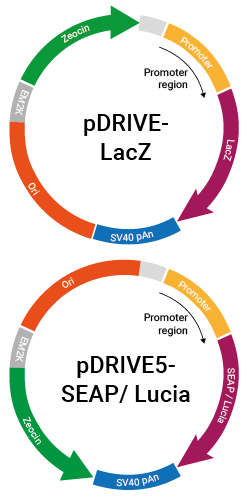pDRIVE Promoters
InvivoGen provides an expanding collection of native and composite promoters provided in the pDRIVE plasmid.
pDRIVE is a family of plasmids with an expanding collection of native and composite promoters. Promoters are valuable tools to study the expression of a given gene both in vitro and in vivo. With InvivoGen's pDRIVE promoter collection, you can choose to express your gene of interest at high or low levels, ubiquitously or specifically, and in a constitutive or inducible manner.
Key features of InvivoGen's pDRIVE plasmids
- Choice of various expression patterns: Ubiquitous, tumor-, or tissue-specific promoters
- Available as native or composite promoters
- Reporter genes: LacZ, Lucia® luciferase, or SEAP
- Fully sequenced and tested in different cell lines
- Simple to subclone due to unique restriction sites
- Selectable with Zeocin™ in E. coli
Plasmid Features
Promoter:
- Ubiquitous: strongly active in a wide range of cells, tissues, and cell cycles
- Tissue-specific: active in a specific type of cells or tissues
- Tumor-specific: active specifically in tumor cells
Reporter gene:
- LacZ gene encodes β-galactosidase, an enzyme that catalyzes the hydrolysis of X-Gal, producing a blue precipitate that can be easily visualized under a microscope. LacZ expression can be determined using chromogenic, luminescent, or histochemical detection.
- SEAP gene encodes an engineered Secreted Embryonic Alkaline Phosphatase. The levels of SEAP in the culture medium of transfected cells expressing the reporter gene can be assayed with our QUANTI-Blue™ detection reagent.
- Lucia® luciferase gene encodes a secreted luciferase. Its intense sensitivity makes it the reporter of choice for the study of weak promoters, such as tissue-specific promoters. Levels of secreted Lucia luciferase can be determined by measuring the luminescence using coelenterazine-based reagents such as QUANTI-Luc™.
These three different reporter genes are available in two different backbones: LacZ reporter gene in pDRIVE, SEAP or Lucia® secreted luciferase reporter genes in pDRIVE5.
SV40 pAn:
- The Simian Virus 40 late polyadenylation signal enables efficient cleavage and polyadenylation reactions resulting in high levels of steady-state mRNA.
pMB1 Ori:
- A minimal E. coli origin of replication with the same activity as the longer Ori.
EM72K:
- A bacterial promoter that enables the constitutive expression of the antibiotic resistance gene in E. coli.
Sh ble gene:
- Zeocin resistance gene, allowing the selection of transformed E. coli carrying a pDRIVE plasmid. Note: Stable transfection of clones cannot be performed due to the absence of a eukaryotic promoter upstream of the Sh ble gene.
In every pDRIVE, several unique restriction sites flank the promoter (a multiple cloning site at the 5’ end and Nco I or Bsp HI at the 3’ end) to excise the promoter easily. These restriction sites are compatible with many other enzymes, thus facilitating cloning. Other restriction sites may be introduced by performing PCR using primers containing the restriction sites of interest. Each product is provided as lyophilized DNA (20 µg) together with 1 ml (10 mg/ml) Zeocin®





